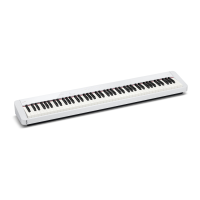Receive Receipt changes the tone. The selected tone is determined by the program value of this
message and the Bank Select message value received prior to this message. For information about
the program number of the actually selected tone, see the Tone List in the User s Guide. Also note
that receipt of this message may also change the Timbre Type parameter at the same time. For more
information, see 10.1 About Timbre Type below.
10.1 About Timbre Type
The tone selected by each part of this Instrument has a Timbre Type parameter that specifies the
type of sound source for the tone. As explained under 20.1Tone Basic Parameters , there are four
Timbre Types settings: Melody, LM Piano, Piano, and Drum. The operation for a received channel
message differs according to the Timbre Type.
• Timbre Type: Melody
This Timbre Typ e is for normal melody tones. The damper pedal performs on/off op erations.
• Timbre Type: Piano
This Timbre Type is for piano tones. The decay rate of the voice being sounded is seamlessly altered
in accordance with the damper pedal position. The method for producing sound in response to the
note messages also is different from that of the melody Timbre Type, and operation is optimized
for piano.
• Timbre Type: LM (Linear Morphing) Piano
This Timbre Type is for Linear Morphing piano tones. The decay rate of the voice being sounded
and Damper Resonance effect characteristics are seamlessly altered in accordance with the damper
pedal position. The method for producing sound in response to the note messages also is different
from that of the melo dy Timbre Type, and operation is optimized for piano.
• Timbre Type: Drum
This Timbre Type is for drum sounds. The method for producing sound is optimized for drums.
The damper pedal and sostenuto pedal do not work for sounds that do not recognize Note Off.
The tuning setting also do es not affect this Timbre Type.
10.2 DSP Assignments during Tone Selection
10.2.1 DSP Line Structure
Though the Instrument has four DSP lines that can be used simultaneously, selecting a tone that uses
DSP causes the required number of DSP lines to become reserved so the tone is configured with the
requisite DSP. For information about tones that use DSP, see 22 Tone with DSP List .
10.2.2 DSP Line Assignment
Selecting multiple tones with DSP at the same time creates the possibility that there will not be enough
DSP lines. In this case, the last selected tone with DSP is given priority. Some DSP line(s) already
being used will be released so they can be assigned to the newly selected tone.
10.2.3 Use of the Same DSP Line by Multiple Parts
When all of the settings below are the same for multiple parts that select tones that use DSP, the same
DSP line is assigned to all of the parts in order to maximize DSP line availability.(Note1)
• Tone Number
• All DSP parameters
23

